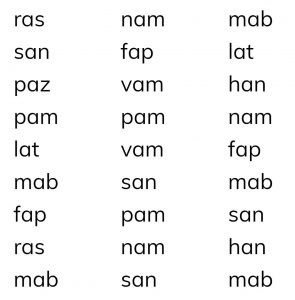Members of the Community Reading FB group asked “What is the proper way to teach the sounds of the consonants?” For example, what is the proper way to pronounce the sound of the letter ‘b’?
The quick answer is ‘b’ as in ‘bat’ or ‘bet’ or ‘but’. But there’s a second part: make sure your child pronounces ‘bat’ as a single syllable, not ‘bah-et’.
 Our Facebook friends in Northern Ireland are fuming. Their schools are using Jolly Phonics, but are teaching the the wrong sounds. They claim that students in school are being taught letters with a leading vowel, for example ‘m’ as ‘em’, or ‘n’ as ‘en’. That causes kids to try to sound out ‘mat’ as two or three syllables: ‘em-ah-et’, and often leads to reading failure.
Our Facebook friends in Northern Ireland are fuming. Their schools are using Jolly Phonics, but are teaching the the wrong sounds. They claim that students in school are being taught letters with a leading vowel, for example ‘m’ as ‘em’, or ‘n’ as ‘en’. That causes kids to try to sound out ‘mat’ as two or three syllables: ‘em-ah-et’, and often leads to reading failure.
And they are absolutely correct. Jolly Phonics is teaching the wrong sounds.
Jolly Phonics uses keywords such as ‘t’ as in ‘tennis’ (with an associated swing of the arm) or ‘s’ as in snake (with an snake-like weave of the fingers). But some of their keys are dreadfully chosen and will cause exactly the problem DyslexiaNI is finding. The ‘m’ is ‘tasty food’ (rub tummy) and makes the ‘emmm’ sound, the ‘n’ is an airplane (arms out) and makes the ‘ennn’ sound, the ‘r’ is a puppy shaking a rag and making the ‘arrr’ sound. DO NOT LET YOUR CHILD DO THIS.

The Jolly Phonics synthetic alphabet. Each sound is associated with a sound and an ‘action’, for example /s/ with ‘sss’ and and a snake-like weaving hand.
The correct way to pronounce a consonant is to put a neutral vowel AFTER the consonant as if pronouncing a real word: ‘b’ as in ‘bet’, ‘c’ as in ‘ket’, ‘d’ as in ‘debt’. (Joyce Shaw, the admin for DyslexiaNI, describes those sounds as ‘bu’, ‘ku’, ‘du’, but I think that is due to an accent difference).
Jolly Phonics could correct their program by changing the dangerous keywords, for example changing the /m/ sound to use ‘mouse’. No one would pronounce it em-mouse. In the meantime, stay away from this damaging program.
 I’m not sure why we teach sounds in isolation at all. The excellent Toe by Toe has a single page for sounds of the consonants (including ‘th’, ‘sh’, and ‘ch’), just a pre-check that the student has the right idea. The two excellent phonics programs that I modeled BLENDING on, ‘Teaching Johnny to Read’ and ‘Phono-Graphix’, don’t teach sounds either and just dive in with real words.
I’m not sure why we teach sounds in isolation at all. The excellent Toe by Toe has a single page for sounds of the consonants (including ‘th’, ‘sh’, and ‘ch’), just a pre-check that the student has the right idea. The two excellent phonics programs that I modeled BLENDING on, ‘Teaching Johnny to Read’ and ‘Phono-Graphix’, don’t teach sounds either and just dive in with real words.
That’s also how the BLENDING program works. We don’t teach any consonant sounds, but rather start the student reading whole words as they would speak them. The very first lesson has the student reading ‘bat’, ‘cat’, ‘hat’.
Only, be very careful that your child pronounces a SINGLE SYLLABLE, it is not ‘bah-te’, ‘cah-te’, ‘hah-te’. Your child must pronounce the word as he would normally say it.
It’s worth testing this immediately with your child. Here are some nonsense words, very simple ones all using the first short vowel /ah/. Have your child read them, and look for any evidence of breaking words into two or more syllables. ANY hint of ‘sah-en’ instead of ‘san’, and you should start remedial training immediately.
Finally, don’t get fussed over the exact sound of a consonant. There is no such thing. Here’s a bit of linguistics: We can only rely on the generalized idea that ‘b’ makes a ‘beh’ sound that is DIFFERENT than the ‘teh’ sound that ‘t’ makes. The ‘b’ sounds are different in each of ‘bat’, ‘bet’, ‘bit’, ‘bot’, ‘but’, ‘bait’, ’beet’, ’’bite’, ‘boat’, ‘beauty’, ‘bought’, ‘boot’, ‘bear’, ‘Bert’, and ‘Bart’. And so are the ‘t’s.
If you want to confirm this, alternate saying a pair of words – perhaps ‘bat’ and ‘bit’ – and focus on how your mouth is forming them. Can you feel how your lips form the ‘b’ slightly differently? You will be able to feel a difference even if you try an almost-identical pair such as ‘bat’ and ‘bag’. (And for fun, compare that to the subtle difference between ‘bat’ and ‘pat’?)
English consonants have neat linguistic properties, but a definitive ‘sound’ is not one of them. The ‘r’ in ‘rest’ is different from the ‘r’ in ‘earn’. The ‘y’ in ‘yes’ and ‘w’ in ‘west’ behave more like vowels than consonants. And none of this is important for reading, your child can learn linguistics in university like everyone else – if you teach him to read properly now.




Leave a Reply